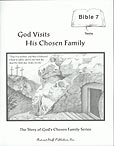





The pupil's book may be used as a consumable workbook or as a textbook. It is designed as a workbook, which allows the student to write answers in the book and to keep it after he completes the course. However, since most exercises are numbered or lettered, schools that prefer to reuse the books for several years may ask the students to write their answers on paper.
The pupil's book is divided into six chapters. Each chapter has five lessons and a review. A chapter is intended to provide work for six weeks. Chapter tests and a final test are available in a separate booklet.
This series (The Story of God's Chosen Family, Grades 5-8) follows a chronological sequence through the Bible. This workbook is a study of the Gospels and Acts. Most lessons have the following sections.
These questions are for optional use during the class period. They provide a continual review of some main points, lessening the need to review everything before the test. If you wish, you may duplicate the questions and hand them to the students for written work or personal study.
This section gives the Bible chapters or verses on which the lesson is based. Important parallel pas�sages from other Gospels are given, but scattered individual verses used in the lesson are usually not included.
Because of time and space limitations, the lesson covers only a few key points rather than giving a thorough coverage of the whole Bible scope. This is especially true for parallel accounts given by more than one Gospel. Additional facts and themes could be drawn from the scope if time permits.
This section provides a brief outline of main events or teachings on which to focus while teaching the lesson.
This section lists important facts or skills that the student should learn. The reviews and tests are based on these objectives.
While one purpose of this course is to teach Bible facts, it also provides an excellent opportunity to convey spiritual truths. Several important truths in each lesson are listed for your benefit. The list is not exhaustive, nor should you feel it necessary to cover all the points mentioned. Rather, the list is for your benefit, to provide inspiration and a sense of direction. Teach as the Lord directs, with truths He has instilled in your heart.
A copy of the pupil's page is provided, with the answers given in colored ink. Teachers should use their own judgment when deciding whether an answer is correct. Vague or incomplete answers will not suffice. When exact answers can easily be found in the Bible, do not give credit for guesses based on the student's previous Bible knowledge. In certain cases, however, some variation is permissible.
This course calls for complete answers when long blanks are given. Some teachers might want to require students to give sentence answers for all long blanks, while other teachers might require sentence answers only when a sentence is needed for a complete answer. Teachers should tell their students what type of answer they will consider complete.
Sometimes the Answer Key gives several options for an answer or has some other directions for the teacher to consider in relation to a question. If this requires too much space to fit in the Pupil reduction, two arrows (>>) direct you to look in the margin for the additional answers or further direction.
Along the right margins are additional directions and notes that you may find interesting and helpful in teaching. The directions are in italic type, with the first line indented. The notes are preceded by bullets.
To keep this workbook simple, metric measures have not been included in the lessons. However, the tables of measure in the back of the pupil's book give metric equivalents, and the answer key gives answers in metric units. If you normally use the metric system, tell your students to give all answers involving measure in metric.
Click on a book to see sample pages.
.jpg)
.jpg)
Click on a book to see sample pages.
| This site is operated by Milestone Books. We are an independent vendor of materials by Rod and Staff Publishers of Crockett, KY. The samples on this site are taken from copyrighted materials, and are shown for information purposes only. |